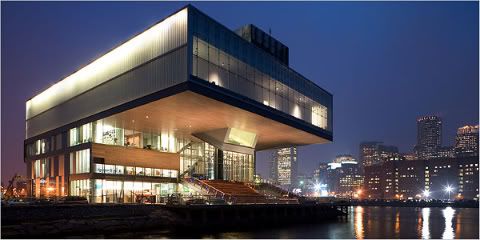[out online] The Titantic drifts into Boston Harbor

Friday night’s ambitious performance of British composer Gavin Bryars’ The Sinking of the Titanic at the Institute of Contemporary Art was a brilliantly set against the ICA’s waterfront location. Performed by a lean delegation from the Boston Based Callithumpian Consort — five musicians, including violin, cello, flute, bass flute, synthesizer; instruments likely chosen because of their fluid-like capacities — Bryar’s minimalist composition called into play the stately beauty of the Titanic disaster.
The first movement reflected the happier times before the iceberg was struck, as synthetic strings mimicked the sound of steel rubbing against the water by resonating against elongated flute and bass flute notes (performed by musicians from behind a sheer curtain). Audience members could watch the activity on the Boston Harbor through the grand window of the ICA’s performance room, as the prepared sounds of oceanic wake and field recordings of Titanic survivors played over the speakers.
“So instead of being submerged by the Titanic, I was floated by the Titanic,” commented one survivor — an adequate comment in light of how art can come from tragedy.
Concert-goes were then moved outside to the back deck of the ICA for the second movement of the piece as musicians stood over large square lights and worked through a harsh, jaunty sequence meant to mimic the distress and aftermath of the Titanic disaster.
The apex of this brought forth when a row boat (meant to represent an escape boat on the Titanic) approached the ICA’s back-deck in the Harbor waters as a lone cellist played an interpretation of the Episcopalian hymn, “Autumn,” which according to most accounts, was performed on the Titanic as it sunk by the Arcadians — the group of musicians who were hired to perform on-board entertainment for the vessel.
Unfortunately though, what should have been the high point of the performance turned out to be a bit of a spiritual fake-out. Probably because sound doesn’t carry well over water, the dramatic effect of the boat rowing away while the cellist played was made possible only through the use of amplification.
So while the audience got to observe the cellist drift out into the Boston Harbor, the sound of his solemn hymn disappearing into the ether was made only possible by a wireless microphone in the boat and someone’s hand very slowly turning down the volume on the house speakers. Even at a difficult volume, the sound of a natural cello, or cellos, fading away on the water would have been much preferable, in terms of natural beauty as well as ghostliness (not to mention that annoying clacking sound which was being picked up by the microphone in the boat!). While maybe a picky observation, the soul of the performance, however risky in its execution, would be more important than guaranteeing a performances effect.



















